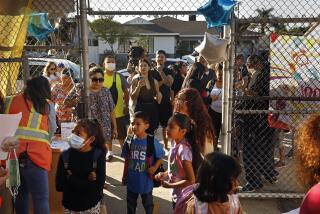No sharing, use ‘airplane arms’: Las Virgenes kids are among first in L.A. to return to school
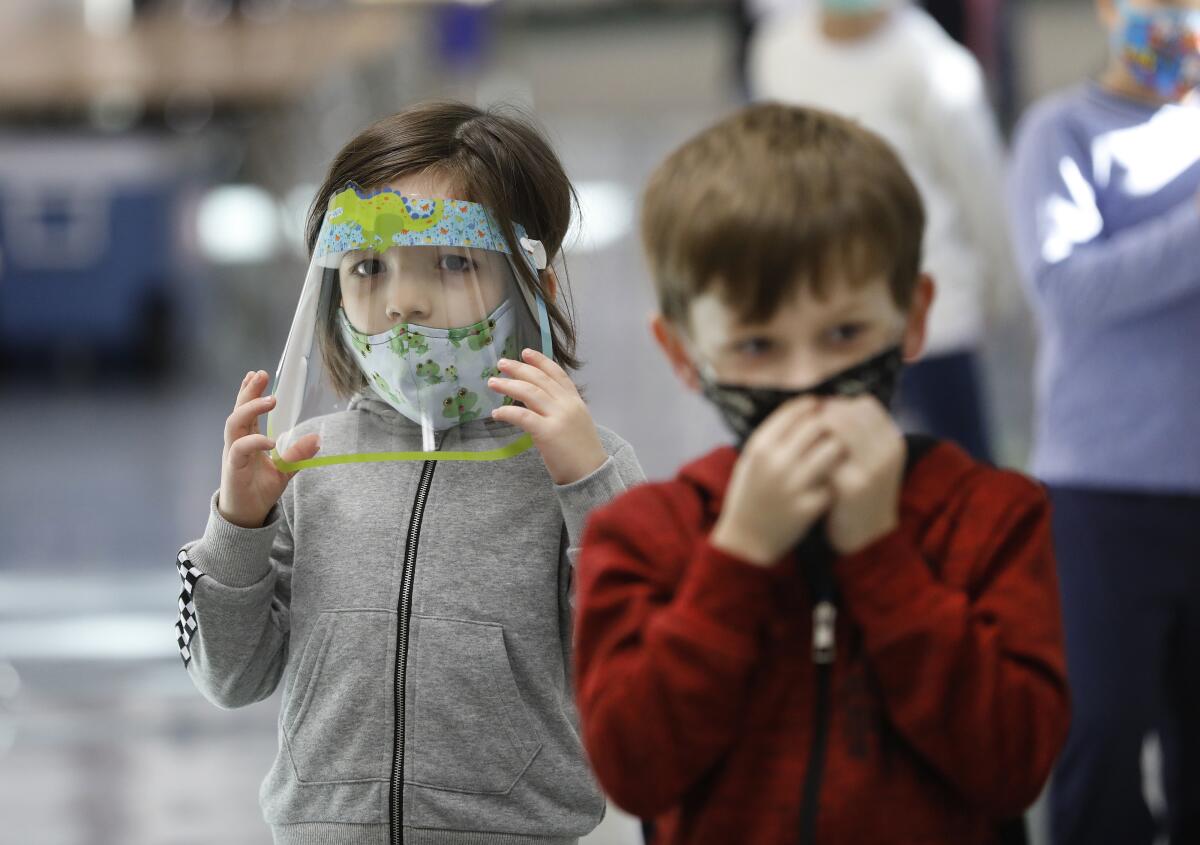
- Share via
Learning to share is typically among the first lessons for kindergartners. But not when hundreds arrived on campus Monday, the first public school children in Los Angeles County to return to something like a regular classroom amid surging coronavirus infections.
No shared pencils or crayons. No sitting together at tables. No bouncing a ball from one person to another. Use outstretched “airplane arms” to keep distant from classmates.
For the record:
6:35 p.m. Nov. 11, 2020This article incorrectly attributed a quote about the Rowland Unified School District to spokesperson Gina Ward. The quote should have been attributed to district Supt. Julie Mitchell.
Yet for all the restrictions they had to navigate, families and officials expressed excitement as their small public school system in the Calabasas area became the first in L.A. County to reopen campuses to transitional kindergarten through second-grade classes under county-approved waivers. These waivers allow campuses to reopen even when COVID-19 infection rates are high. About 2,000 students set foot in classrooms for in-person learning 55 days into the school year.
“We’re excited to get started!” Supt. Dan Stepenosky told The Times. His district straddles the L.A. County-Ventura County border but sits mostly within the jurisdiction of L.A. County, so his waivers were granted by that county’s Department of Public Health. “Most parents are over-the-moon excited,” he added.
Similar expressions of joy and relief — mixed with residual concerns — will be playing out at dozens of local elementary schools in the coming weeks, but not initially in a way that is equitable for all students.
As of Monday, the county public health department had granted waivers to 74 elementary schools, a tiny fraction of the 2,200 public schools in L.A. County. The vast majority have gone to private schools. The health departments in Pasadena and Long Beach have granted 10 additional waivers — all to private schools. Similar narratives have played out in other California counties.
Although more public school districts are beginning to enter the application process, the county’s largest school systems and many serving large numbers of students from low-income families, including Los Angeles Unified, are not applying, citing major safety concerns as the county remains in the most restrictive purple tier under the state’s four-phase reopening plan — indicating widespread transmission of the virus. Some cite lack of funding to provide necessary health and safety equipment as well as resistance from employee unions.
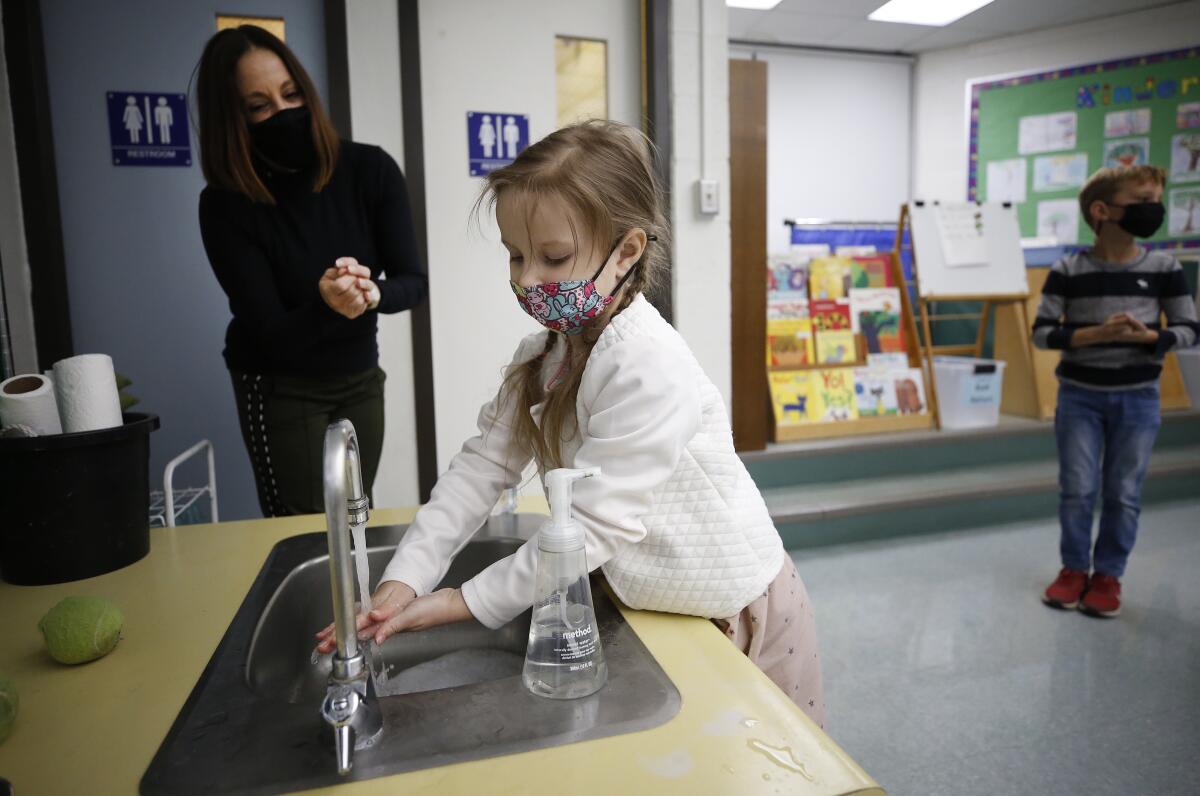
Fear about the virus persists even where families are returning their children to campus.
Liraz Benelisha got teary seeing her son off to kindergarten — no non-employee adults are allowed on campus. Though happy that he’d finally get to meet classmates in person, she was worried.
“Outside of school, some people are still not wearing masks, still socializing as if nothing is happening,” she said. “I’m trusting others with my son’s health.”
In seeking waivers, many private schools took employee concerns into full account, but there were no unions to push for additional safety measures. L.A. County initially made employee support for a waiver mandatory but later dropped that requirement. The county’s process now simply requires outreach to employees, which aligns with state guidelines. With this change, public schools could catch up to private ones on waivers, but school districts remain cautious about working through concerns raised by unions.
Even before waivers became available, many private schools moved quickly to bring back large numbers of students with “special needs,” when that became possible in L.A. County on Sept. 14. These rules allow up to 25% of a school’s students on campus at any given time.
When waivers also became available, these schools’ safety protocols already were in place, often including outdoor, tented classrooms for part-time instruction, new HVAC systems that filter the air and desks separated by plexiglass. Some have required regular coronavirus testing of students and staff.
Many private schools interpreted the special needs provision to include all of their youngest students. The county has left it up to educators to define special needs.
Chadwick School, which is applying for a waiver, brought back kindergarteners at the end of September, and first and second graders in mid-October to its Palos Verdes Peninsula campus. Next week students through 12th grade will begin weekly visits to campus.
Westside Neighborhood School in Playa Vista, which has received a waiver, welcomed its 85 kindergarteners and first-graders back in early October. Higher grades are gradually being worked back into campus life.
The school has established a surveillance COVID-19 testing program, with 900 tests issued to students and staff so far — all with negative results, said Head of School Bradley Zacuto.
Some private schools have gotten creative with outdoor instruction. Seven Arrows Elementary, a small private school in Pacific Palisades, has brought each grade back for “youth conditioning,” which is allowed under county guidelines.
Twice weekly, teachers will take their cohorts of 12 to a park or nearby Will Rogers State Beach, where students swim and do shoreside yoga.
“It has been a game changer,” said Seven Arrows Head of School Margarita Pagliai. “It allows children to see each other, to make connections, and get a lot of energy out so when they get on Zoom they’re laser focused.”
Seven Arrows also received a waiver and is gradually phasing students back to in-person instruction, with 60 K-2 students on campus already.
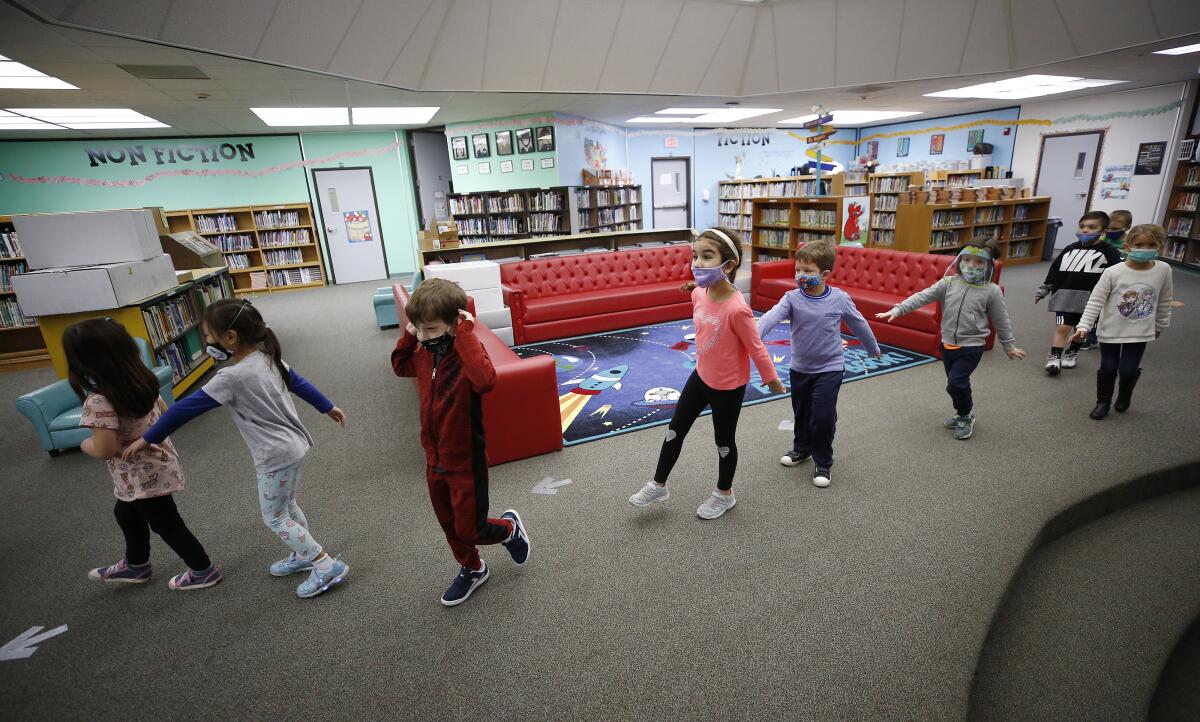
Las Virgenes was able to open with a waiver after winning a union endorsement. El Segundo Unified also won backing from its employees as part of its successful waiver applications. Its two elementary schools are likely to open in early December. Other local school systems with approved waivers through Monday are La Canada Unified and Manhattan Beach Unified. All four school systems serve comparatively prosperous communities — and also areas where coronavirus infections rates are lower.
Palos Verdes Peninsula Unified is applying for waivers, but Supt. Alexander Cherniss also would like to see authorization for a more general reopening in parts of L.A. County where infection rates for the coronavirus are comparatively low.
In a public town hall Monday, county Public Health Director Barbara Ferrer said state rules don’t allow counties to reopen in sections. She also noted that infections rates are currently rising in virtually every L.A. County community.
In reopened schools, Ferrer said Monday, there have been “three or four” cases at 10 schools so far. One school reported nine cases after a group of students went to Arizona to play a baseball game. Participants got infected, then came home and infected others, she said. Ferrer did not name the school.
Los Angeles Unified, the nation’s second-largest school system, has not applied for reopening waivers but is providing one-on-one tutoring and small-group instruction for up to three students at a time for those with special needs. The district recently said about 1,000 students were participating among its 460,000 K--12th-grade students.
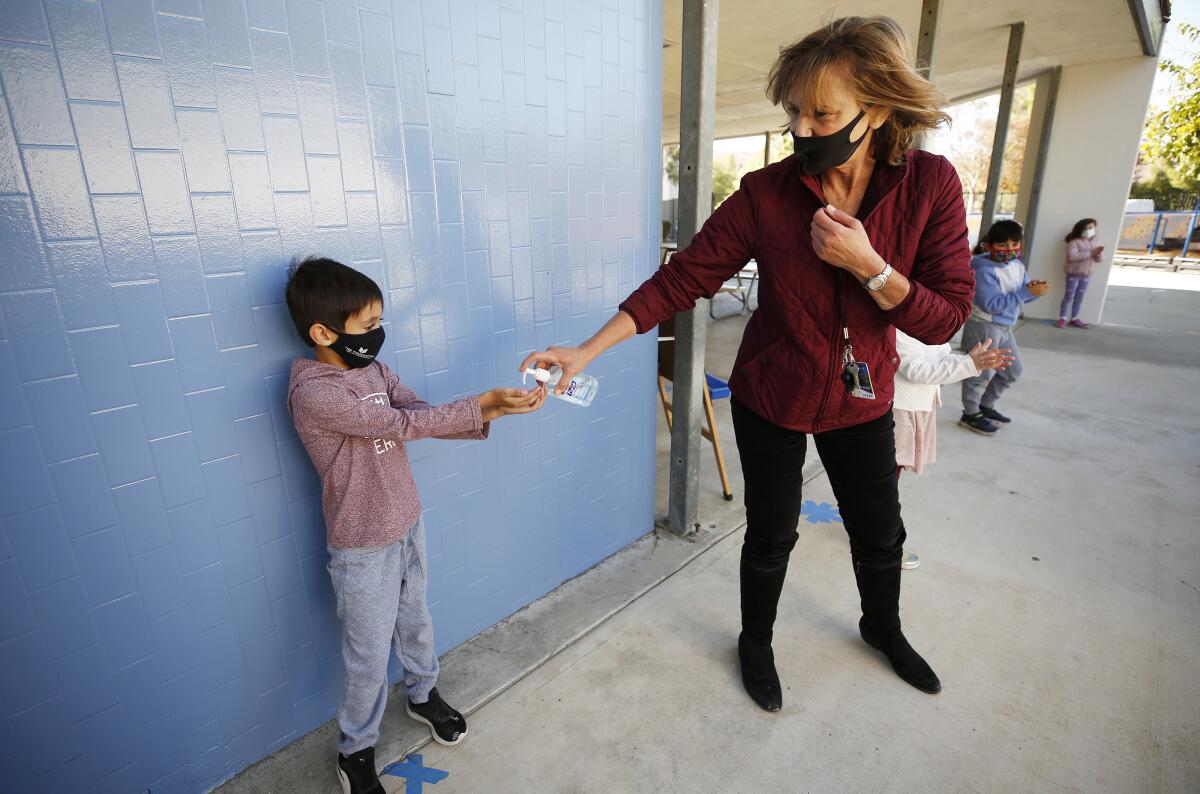
Rowland Unified, a diverse San Gabriel Valley school system, is on a similar track and reached an agreement Friday with its teachers association to begin in-person one-on-one assessments for students with disabilities.
“This will be the first step in bringing students back,” district spokesperson Gina Ward said. “Both the union and the district are committed to the safety of all students and staff.”
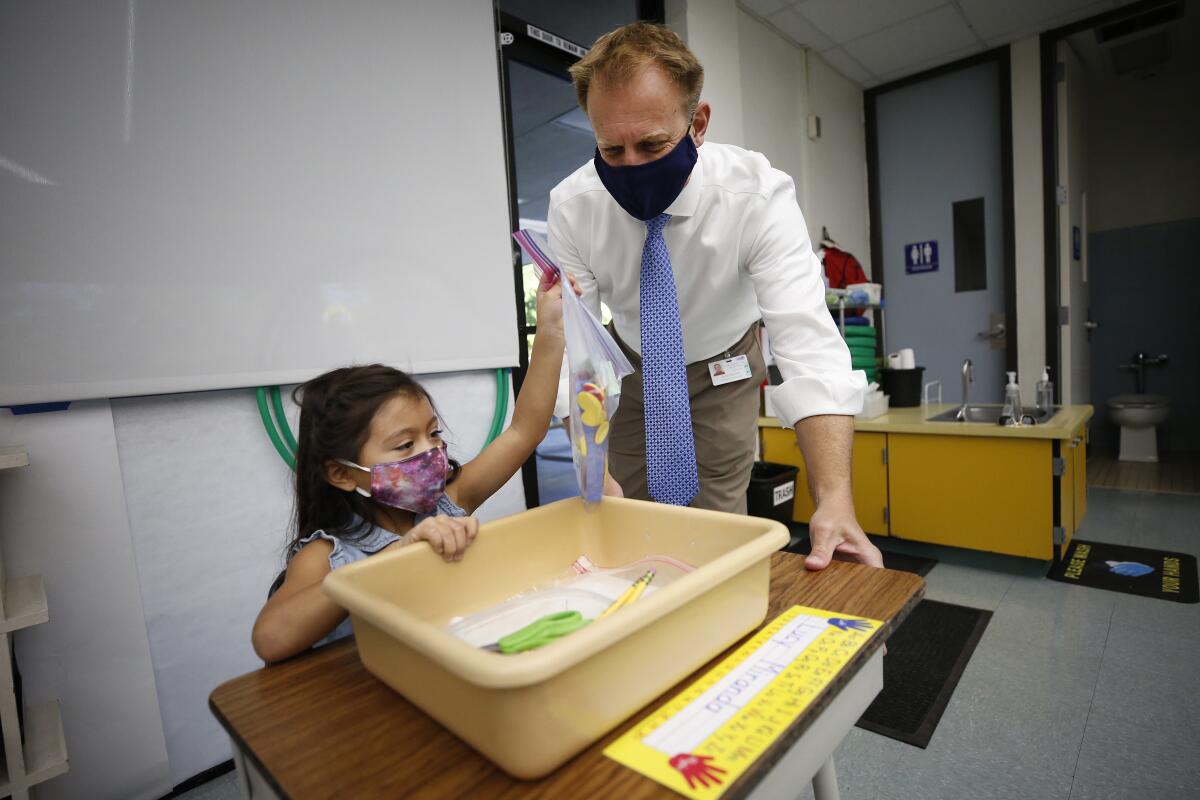
On Monday, children encountered new rules and procedures as they entered Lupin Hill Elementary in Las Virgenes Unified.
Students underwent two temperature scans: one outside and one just inside the school building. A temperature of 100 degrees or higher means they are to turn around and go home. Masks are mandatory for all — even the youngest students — except during lunch.
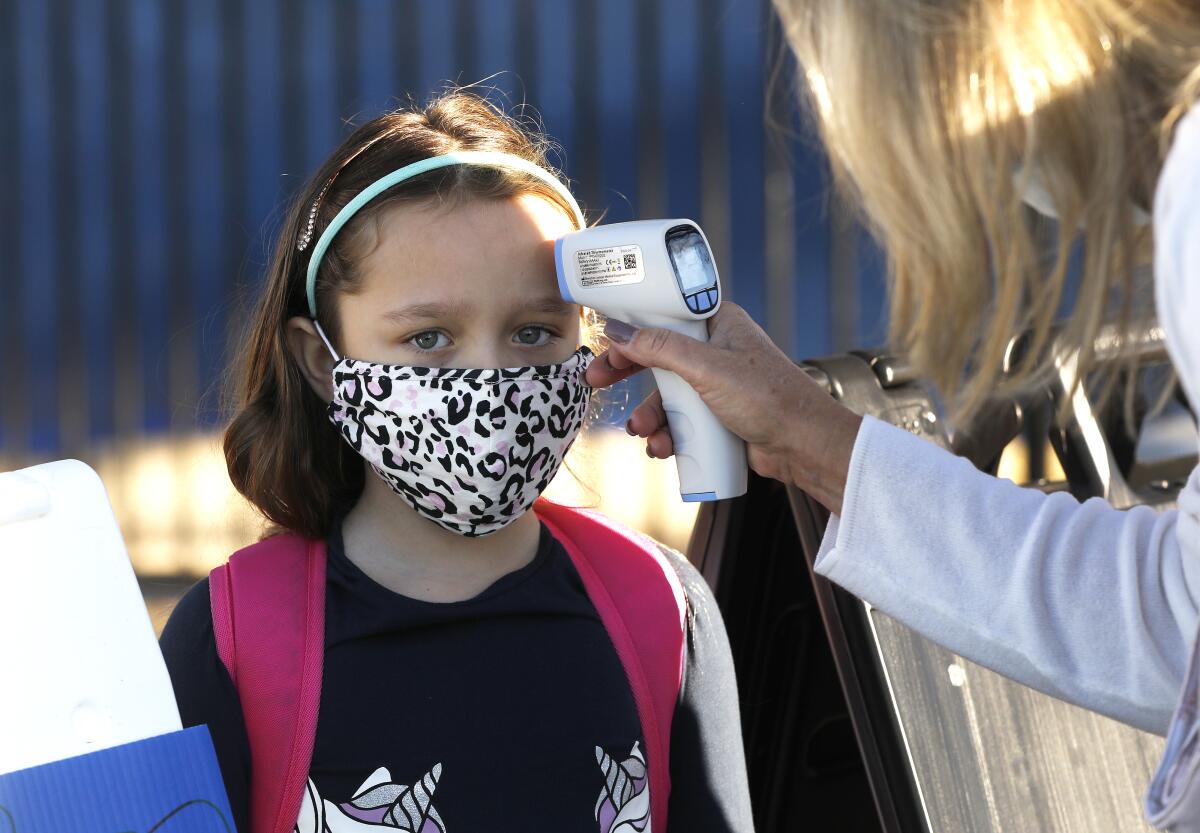
The color of the day is blue and the shape of the day is a circle. Blue dots designate how far apart students have to be in class, on the playground and in eating areas.
In Jennifer Klein’s kindergarten class, all students received their own supplies.
“Why can’t we share them?” she asked her students.
Olivia Johnson raised her hand.
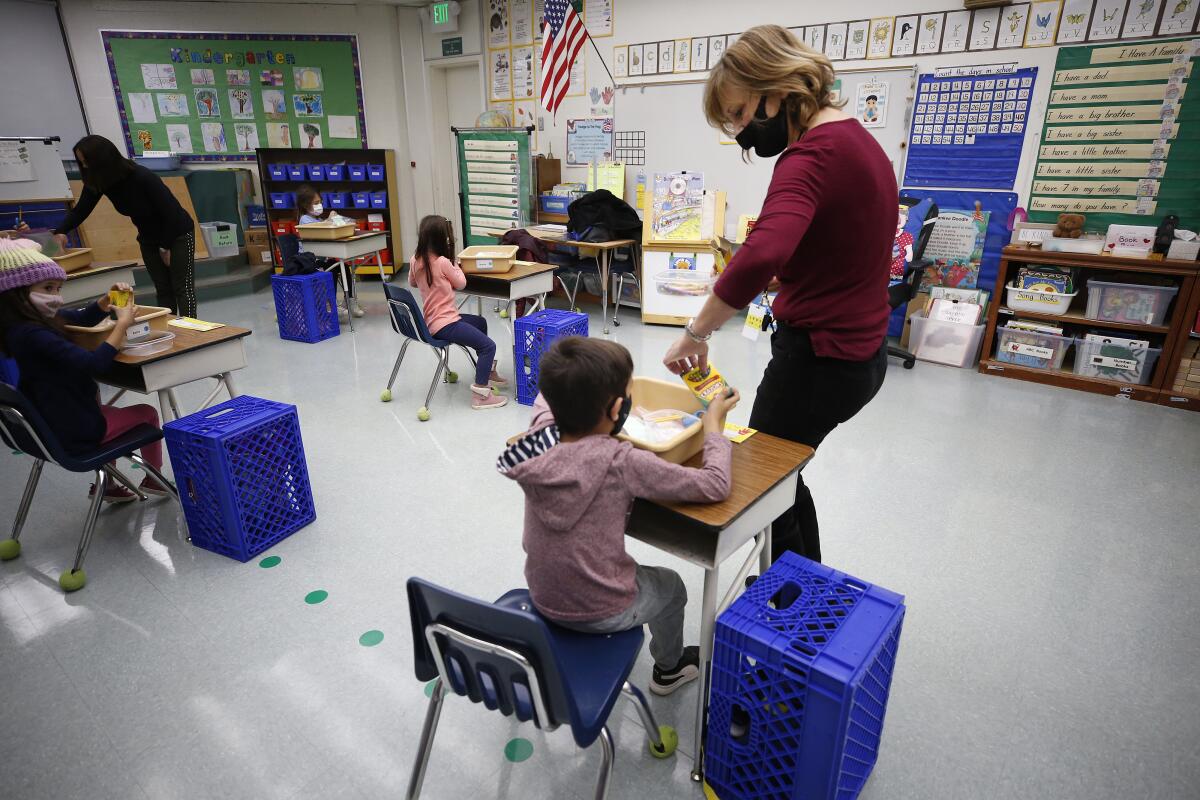
“Because of the corona,” she said without hesitation from behind her white mask, which complemented her light pink, sequined high tops.
No class can have more than 12 students, as well as two adults, a teacher and an aide. The morning session lasts from 8:15 to 10:40 a.m. Then there’s a cleaning session before a different afternoon “cohort” attends class from 12:25 to 2:50 p.m.
Cleaning-crew member Terrence Littlefield starts every morning with a new mask, a stack of wipes and hand sanitizer.
“No complaints,” said Littlefield, who’d been on unemployment since July and is happy to be back at work. “Everything we’re doing is necessary to keep everybody safe.”

“We have to get this right,” said Supt. Stepenosky. “We can’t open up and become a super spreader.”
But he’s not too worried: “In reality, students have been training for months,” he said. “Plus, schools aren’t bars or football games. Students know they have to follow the rules.”
More to Read
Sign up for Essential California
The most important California stories and recommendations in your inbox every morning.
You may occasionally receive promotional content from the Los Angeles Times.

